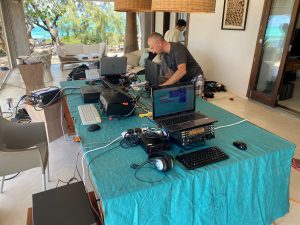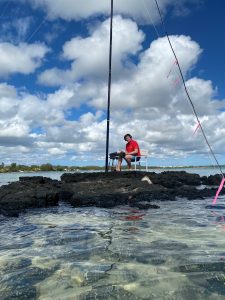Category - Uncategorized
Back in 2019, following my Single Op entry in CQWW CW ass G9Y, I was approached by Olof G0CKV who told me that he had plans to operate in the CQWW CW contest from Mauritius as 3B8M in 2020. We made plans and we were preparing to travel to Mauritius in time for the contest, however we encountered a well-known issue that many travel and Amateur Radio enthusiasts alike have encountered. The COVID-19 restrictions meant that we were uncertain how a trip to Mauritius would go. This was around the time when nobody knew what the virus was, and governments were beginning to instate restrictions on travelling and eventually full country lock downs. This meant that we would have to put this trip on hold until further notice. Of course, this went on for much longer than anyone anticipated, and we had a full year during 2020 when we were not allowed to travel at all and many of us were restricted to our homes, unless of course like me you were considered a “key worker”. In which case, business as usual. The government and media tried to make us feel special by calling us “key workers” and even encouraging the Clap for the NHS to turn into the clap for key workers. But how special can you really feel whilst you are slaving away, most likely in some sort of service industry whilst the rest of your friends and family stayed at home enjoying what was an incredible summer for the UK. I digress.
Olof approached me again around mid-2021 with some information from the tourism authority in Mauritius where it was advertised that they would be lifting the travel ban and we would be able to take another attempt at this trip. Of course I was in!. Olof assembled a team of contest operators consisting of Kazu JK3GAD/M0CLF, Oliver W6NV, Denny KX7M, Olof G0CKV an of course me M0SDV. We all made our plans and booked tickets to travel to Mauritius in November 2021.
Some time before the trip I met up with Olof and Kazu at Olof’s home near to London. This was a long drive for me however a good opportunity to get reacquainted before the contest. Olof had prepared VDA antennas and required the assistance of Kazu and I to tune then ready for deployment in Mauritius. We got this done quite quickly and afterwards we began working on radials for 160m. Now, 32x 25m long radials, measured, stripped at the end and put into bundles of 4 into the crimp connectors and rolling them all up neatly, is quite a laborious task; However, we were able to make light work of it.
Fast forward to November. Olof and his Wife Elizabeth were already in Mauritius enjoying a holiday before we all arrived. The checked into our accommodation in Roches Noires the weekend before CQWW CW and were joined by Oliver W6NV and Denny KX7M not long after. Kazu JK3GAD and I arrived the following afternoon. On our arrival, those who were already there had made a start on the antenna work and had 3 VDA’s assembled on the ground ready to be erected. The unique location at L’Ilot provides a perfect operating facility for amateur radio operators and it has been used in earlier years by Olof and the team for their 2019 contest expedition, as well as being the QTH of choice for Nigel OE5TXF who operates often as 3B8XF from this exact location.
With part of the work already done, it was easy for me to jump right into station building work. We began putting up the VDA’s with the bottom of the pole submerged in the salt water, with a clear ocean take off to Europe, North America, and Japan. We installed 2x stacked VDA’s for 20m, and single VDA’s for 15 and 10m. We also installed a 160m top loaded ‘umbrella’ vertical, 80m Inverted L and almost full ¼ wave vertical dipole for 40m. These were all located with their feet in the ocean. The 40m antenna was placed on a rock and the (waterproof) coax lay in the sand under water back to the shack, somewhat mimicking the efforts of the BS7H team on their Dxpedition to Scarborough reef, (more on this later).
Throughout the week we tested antennas as well as getting a feel for band conditions and when the best openings were happening around the world, which was a good time to practise for the upcoming CQWW CW contest which we were participating in. By doing this we were also able to shake down the station and working on any QRM issues which were to arise. And over the course of the week, we tested each of the stations to ensure full functionality throughout the entire station and work out any kinks which could cause us issues later.
During the contest we ran 4 operating positions, each equipped with an Elecraft K3 and then a selection of amplifiers including 2x SPE 1.3Kfa, 1x SPE 1.5kfa and an Elecraft KPA500 (with thanks to Clive 3B8CW for assisting). As can be imagined, running four stations with five operators was a challenging task, however we were able to utilise 3 station which would be permanently placed on bands which would not typically be open at the same time and one ‘roving’ station which would have access to all un-used antennas to catch band openings, multipliers and keep an eye on how propagation was doing. When contest time came, we arranged a schedule of who would operate on what bands and between what time. Personally, I was band lead for 15m, which I thoroughly enjoyed. The band was open from sunrise until long after sunset offering very high QSO rates and even more importantly, giving me an opportunity to sleep at night between band closing and re-opening the next morning. On average each day, I spend 15 hours in the chair with occasional short comfort breaks which were covered by anyone spare. Throughout the contest we found conditions to work reasonably well. 15m was open for the longest amount of time, there were good openings on 10m and 20. Throughout the night when the low bands opened, we continued to be productive, however we were hindered by local QRM which we could not isolate. Even so, we produced good results on all bands.
Following the contest, we were able to focus of some DXing and operating on some other WARC bands. 12m was operated due to popular demand and provided a good number of QSO in and across Europe. Following this we started to dismantle the station, which brings me onto the earlier link to BS7H.
Throughout the week we noticed that the 40m vertical was on a very large rock, similar in size and style to those on Scarborough reef. We decided to leave the 40m antenna up until the very last minute to we could take some pictures, and what would come next will be quite amusing for some. Denny KX7M and I went wading through the ocean with a small table, a chair and Denny braved his Elecraft K3 for the purpose of some photos and we set up on the rock in a spoof re-creation of the images from BS7H. We held up the latest Radcom and had pictures took where it looked like we had been operating from the rock during the contest. I personally was not into Amateur Radio at the time of BS7H, however it brought back some memories for those who are of this incredible DX-pedition that took part in 2007. Following our bit of fun, we packed the remaining antennas and gear down ready for the team to start departing.
On the last evening we had a final team meal together, where we discussed how the contest had gone and developed ideas and plans on what we could have done better and what we intend to change for the next time round. Following some drinks, food and laughter on the following morning the team began to depart. Kazu and I were the first to leave, shortly followed the next day by Oliver and Denny and later Olof and Elizabeth would fly back to the UK. Easy right? Wrong! This was during a time where COVIF from African countries had begun to evolve and spread. The UK had introduced new isolation and testing measures meaning everyone travelling to Gatwick would require a different type of test, which meant quickly booking last minute PCR testing for arrival. And Those flying back to the USA would require PCR tests on Mauritius before they were allowed to board the aircraft home. This was a small hurdle and one we all navigated without too much trouble or extra expense.
This was a great trip and one I was pleased to be apart of. There is a lot to be learned by traveling the world, building a multi-multi contest station, and making more than 10 000 QSO’s over one weekend. And that doesn’t consider the QSO’s made prior to the contest. The team intend to return in 2022, potentially with a change to the operators, but 3B8M will be QRV again!
73, Thanks for working us!
The Monach Isles, also known as ‘Heisker’, are a small group of islands located West of North Uist in the Outer Hebrides of Scotland. The islands which were once home to a small settlement of people and animals, however, have remained uninhabited since the last person left in 1942. Now the isles are a nature reserve, home to a number of bird species, a flock of sheep and one of the largest colonies of Seals in the world, among other things. Cean Earr was our island of choice due to it being the largest island within the group. This island was the main settlement before it was left to nature. The island contains an 1800’s schoolhouse which is owned by a group who have family ties to the island. The house was renovated making it a good place for us to stay on the island, where is would be warm, dry and give us a place to set up base.
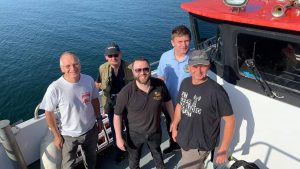 On Tuesday 20th JULY 2021, our team of 5 amateur radio operators consisting of Nobby G0VJG, Chris G0FDZ, Jamie M0SDV, Pat EI5IX and Tony G2NF set off on their journeys from their homes in England to make the long treck to Monach. The first stretch of the journey was to drive to Oban in West Scotland, where we would get a ferry to Barra, where the team met in a hotel and prepared for travel to the Monach’s the following day. We all stayed overnight on Barra before taking our equipment to the jetty on Wednesday morning. We carried all of our gear down onto the jetty and we met our Boatman Angus and his crew on the ‘Spirit of Hebrides’ which would be the vessel to take us to the island Cean Earr in the Monach isles. The process of moving the equipment from the cars to the boat was a laborious one but once the boat was loaded we were on our way.
On Tuesday 20th JULY 2021, our team of 5 amateur radio operators consisting of Nobby G0VJG, Chris G0FDZ, Jamie M0SDV, Pat EI5IX and Tony G2NF set off on their journeys from their homes in England to make the long treck to Monach. The first stretch of the journey was to drive to Oban in West Scotland, where we would get a ferry to Barra, where the team met in a hotel and prepared for travel to the Monach’s the following day. We all stayed overnight on Barra before taking our equipment to the jetty on Wednesday morning. We carried all of our gear down onto the jetty and we met our Boatman Angus and his crew on the ‘Spirit of Hebrides’ which would be the vessel to take us to the island Cean Earr in the Monach isles. The process of moving the equipment from the cars to the boat was a laborious one but once the boat was loaded we were on our way.
The journey to the Monach’s took around two and a half hours across and unusually calm North Atlantic Ocean. During this journey we were slightly delayed as we approached the Monach Isle’s as we were hailed by the Stornoway Coast guard who said there was a vessel which had run aground nearby, and the was not answering radio calls. We altered our course and went to investigate where we were able to get eye’s on a grounded vessel, and after a while of trying we were able to establish a radio communication with the vessel, who confirmed that they were all safe and they’d mis-judged the tide. Once we were assured of their safety, we continued to the beach on Cean Earr where we landed.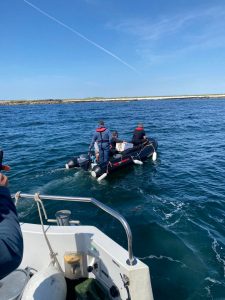
The next stage is where the hard work really began. Our task was to move all of the radio gear from the beach where we landed to the house where we’d set up the station. We quickly realised that the sack barrow that we had packed would not work on the rough terrain ahead. The house was a good 350 meters away and slightly up hill from where we landed, across bumpy ground made up of thick grass and many ditches and holes that we’d have to look out for. Luckily, we were able to find 2 wheelbarrows and even a boat trailer on the island which were a huge help in getting things moving. That said this was still no easy task and it took us around 4 hours of non-stop back and forth with heavy boxes, up and down ditches and a few trips and falls along the way. However eventually, we all made it into the house with the equipment to hand so we could begin setting up.
That evening we put up our WARC band dipoles on a Racal mast, 12m high. We placed this on a small mound that was near to the house which easily gave us an extra 2 meters in height. This allowed us to start working stations on whichever bands were still open. In this case 30m CW proved best to make a handful of QSO’s before we continued with shack set up and eventually get some sleep after a long first day.
The next morning, we wasted no time at all in getting the rest of the antennas up. We split up into teams to get the most done. Nobby and Jamie went straight to work putting up the hex beam which would be our only directional antenna which covered 20 – 6m. Pat and Tony started constructing our 40 and 80m dipoles which went on the Racal mast with the WARC antenna, whilst Chris organised the shack set up inside, arranging operating positions, computers and switching, whilst still finding time to help with antennas in between tasks. Over the period of the day, we were able to get most antennas up which gave us a functioning contest station and minimal work to do Saturday morning before the contest.
On Friday evening, to our surprise, we saw a group of people on the island. Yes! Other people on this small uninhabited island in the North Atlantic Ocean, they’d set up camp on a rock in the distance. Presumably Yachters who needed a place to stay for the night. We saw them setting up camp in the distance on a rock near to where we had landed on the East side of Cean Earr.
Come Saturday morning all we had to do was install a 40m, 20m and 15m vertical and connect it to the switching unit. Whilst we were finalising this set up we were approached by the group of campers we had seen the evening before. They were interested in all of the masts and wire that were hanging all over the place. After a short conversation we were able to explain that we had arrived on the island to operate in an amateur radio contest, and we’d be here until Tuesday. They were very understanding of what we were doing and were even able to help us with some generator maintenance by providing some spare oil from their boat to keep us ticking over. Following this unexpected encounter we carried on working and by the time the contest came around we were ready to operate. Up to this point we had made minimal QSO’s only on the WARC bands, this helped us maximise QSO’s on contest bands over the weekend.
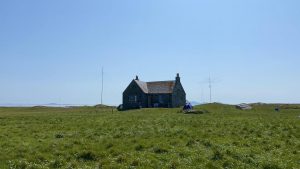 During the IOTA contest we opted for the multi 2 low power category, meaning we would run 2 radios simultaneously for the full duration of the contest. We started out on 40m and 20m SSB for the first part of the contest where 20m allowed high rate to Europe and 40m allowed us to get those 5 points “inter G” QSO’s. Conditions throughout the contest were up and down and sometimes we found that we could easily work multipliers and get through pile ups and other times it took a lot of patience from the operator to ensure we worked as many multipliers as we could. Despite only running 100 watts throughout the contest, we were able to work a respectable amount of islands stations from all continents. At times we ran pile ups to Europe and North America but at other times search and pounce was the only way to keep any kind of rate, nonetheless we made 1892 QSO during the contest reaching a score of ….
During the IOTA contest we opted for the multi 2 low power category, meaning we would run 2 radios simultaneously for the full duration of the contest. We started out on 40m and 20m SSB for the first part of the contest where 20m allowed high rate to Europe and 40m allowed us to get those 5 points “inter G” QSO’s. Conditions throughout the contest were up and down and sometimes we found that we could easily work multipliers and get through pile ups and other times it took a lot of patience from the operator to ensure we worked as many multipliers as we could. Despite only running 100 watts throughout the contest, we were able to work a respectable amount of islands stations from all continents. At times we ran pile ups to Europe and North America but at other times search and pounce was the only way to keep any kind of rate, nonetheless we made 1892 QSO during the contest reaching a score of ….
Following the contest, we took some time to work all bands and modes that were open, and we had the capability to operate. We started making more QSO’s across all bands instead of targeting only WARC bands like we did before the contest. As we were no longer bound by contest rules, we utilised a Juma PA1000 operating 400 watts on generator power, to enable us to work more DX including West coast North America and Japanese stations who were in need of the rare EU-111 as a new IOTA. We even managed to make some QSO’s to Australia (VK) on 15m.
The tear down process was reasonably streamlined and much quicker that getting everything up. The vertical antennas were taken down fairly quickly after the end of the contest and everything else apart from the Hex beam was packed away on Monday afternoon, prior to our departure on Tuesday morning. We packed all non-essential items in waterproof boxes and began to stage equipment near to the beach so that there would be less journeys on Tuesday when the boat arrived to pick us up. We kept 1 radio, with the Juma amplifier and Hex beam running until the very last minute. This allowed us to continue making QSO’s on Monday night whilst the bands were still open and maximise our time on the island.
Come Tuesday morning everyone was up bright and early in order to finish packing and make our way to the beach where we would meet the ‘Spirit of Hebrides’ and her crew. It is worth noting that this was the worst day we had in terms of weather as it was raining from when we woke up and continued whilst we were moving equipment from the house, back to the beach, this made it very difficult to move through the thick grass and made us all wet and cold, bringing team morale down, but we pushed through. The final radio was packed away and the hexbeam dismantled. We packed our personal items and began the long process of hauling the rest of the equipment back to the beach. Thankfully this process was streamlined due to our efforts the day before in staging some equipment ahead of time, however it was still no easy task.
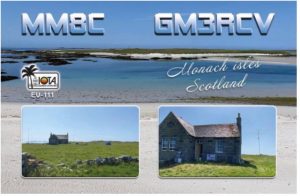 Once the vessel had arrived, the crew anchored off shore and made their way to us by zodiac. We loaded all equipment and operators over the space of two hours through the pouring rain and sea’s much more active than when we arrived. When we boarded the ‘Spirit of hebrides’ it was made a priority to get changed into dry clothes so that we would not freeze on the long journey back to Barra. Following this trip back to Barra we were dropped on a different Jetty to what we loaded as this made it easier to get our kit directly into the cars. We made our way back to the hotel and checked in. It is at this point where you realise how much you take the little things for granted. Hot running water and the ability to have a proper shower was second to none, then clean clothes, real cooked food, and a cold pint. Writing this makes it sound like we were away for months, but you begin to miss the small home comforts even after only a week away on an island with no fresh water or electricity.
Once the vessel had arrived, the crew anchored off shore and made their way to us by zodiac. We loaded all equipment and operators over the space of two hours through the pouring rain and sea’s much more active than when we arrived. When we boarded the ‘Spirit of hebrides’ it was made a priority to get changed into dry clothes so that we would not freeze on the long journey back to Barra. Following this trip back to Barra we were dropped on a different Jetty to what we loaded as this made it easier to get our kit directly into the cars. We made our way back to the hotel and checked in. It is at this point where you realise how much you take the little things for granted. Hot running water and the ability to have a proper shower was second to none, then clean clothes, real cooked food, and a cold pint. Writing this makes it sound like we were away for months, but you begin to miss the small home comforts even after only a week away on an island with no fresh water or electricity.
A lot of people came together to make this DXpedition happen and a huge thank you has to go to Angus and his crew on the Spirit of Hebrides, as without them we would never have made to the Monach isles and back. The crew were a great help and were willing to help us shift our equipment to and from the jetty and boat, their excellent knowledge of the sea and local islands made our trip smooth and go off without a hitch. A thank you also goes to the keepers of the old schoolhouse on the island who allowed us to stay in the house which kept us warm and dry and enabled us to operate on the island. Also, a huge thank you to Cray Valley Radio Society for use of equipment and help with funding the DXpedition.
I’m excited to try out a new antenna I’ve been working on. It’s an adapted take on a design by DJ0IP for a 160/80m antenna on an 18m pole. The original desin of this antenna (pictured below) is a top loaded vertical for 160 with an 80m Inverted L hanging from the side.
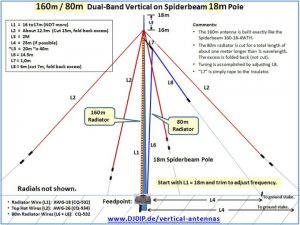
Here is the DJ0IP design, Credit: http://www.dj0ip.de/vertical-antennas/160-80m-on-18m-pole/
I will say early on that I am not an expert, just an experimenter. The M0SDV design is slightly different. There is no shared feed point, and No shared ground plane. Instead they are two independent mono band vertical antennas from the same mast. This is an 18m spider beam pole. The 80m vertical is 1/4 wavelength with 2x elevated radials approximately 3m above the ground. To allow for a wide spaced coil at the base of the antenna I have built a frame from plastic tube to separate the 160m and 80m elements by 1m.
The 160m antenna is a “T” vertical using approximately 17m vertically and each leg of the top hat is about 15m long. This is over a pre laid ground plane. You might be wondering what I have used for the ground plane. I am not sure how effective this will be but like I said, I am an experimenter not and expert. Due to lack of space in my garden my radials are between 16m and 20m long going is multiple directions. This idea is taken from M0MCX at DXcommander who has modeled vertical antennas and shows that having shorter radials can also be effective. To add to this, I have 2 earth rods approx 1.5m under ground. I am not sure about the effect of the earth rods, but if you know maybe you can email me with your thoughts. and because I had extra wire I decided to tune 1x elevated radial along the fence. This combines multiple techniques that I have used before. Over the coming weeks and during CQ160 CW I will test this antenna and work on improvements for future.
I should also mention that each antenna goes to earth when not in use to avoid interactions between the two elements. As I repeat over and over, I am an experimenter, not an expert. Please feel free to email me your suggestions and comments… but for now 73 es CU on 160!
So what have I been up to since the last time I posted in this blog?… March saw me jet off to Togo with the EIDX group where we operated for 2 weeks as 5V7EI. The team consisted of 14 operators from 6 countries. Over the period of 2 weeks we made in excess of 50k QSO’s making one of the highest QSO numbers on any EIDXG DXpedition. A full report on this will be published soon.
Following my return from Togo I participated in CQ WPX SSB from the station of Nick G4FAL, I operated for close to 36 hrs using the call sign M7K, I made a little over 2600 QSO’s with a total Score over 6 million points as a single operator. I also participated in CQ WXP CW from M6T, again single operator making shy of 3000 QSO’s and over 6 million points again.
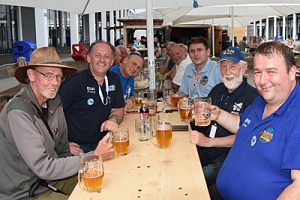
L-R: ?, Jeremy EI5GM, Nobby G0VJG/FW5JG, Jamie M0SDV, Norbert DJ7JC & Dave EI9FBB
I paid a visit to Ham Radio in Friedrichshafen, where I saw old friends and met some new people who I hope to operate with in the future. I always find this events a great place to socialise, catch up, make new friendships and network with fellow DXers and contest operators. Here is a picture taken by Nigel G3TXF of me enjoying the company some friends.
In the coming months I will have some more DX trips. Firstly I will get a visit from my friend Phil DK6SP from Bavaria, and together we will travel to Ireland stopping in Dublin on the way to DX Feile hosted by the EIDX group on Aran Island (IOTA EU-006). There will be a Social event and a programme of talks for us to enjoy, as well as a station to activate the IOTA as EJ1D. More information can be found here > www.dxfeile.ie
And in October I will be heading for Cyprus where I will operate as 5B/M0SDV and P3F during the CQWW SSB contest, Many thanks to Bob 5B4AGN for hosting me at his home on the island. I’m sure there will be some fun pile ups to work whilst I am there.
As for further ahead only time will tell what I’ll get up to, No doubt planning for more DX and contest trips. Exploring the world and making many more ham radio friends along the way. Keep an eye here for my next update!
As we approach the festive season many companies are starting to slow down for the year. Here at United Radio we like to push through to bring you the very best and fastest service. However our postal carrier here in the UK, Royal Mail, start to slow their collections.
Last post for mail to arrive before Christmas is 18th December. After this time Mail posted is unlikely arrive before the 27th December. Therefore I will have a Close down period for 1 week between 20th – 27th December. This gives me time to spend time away from my desk and with my family through the festive period.
I would like to thank everyone for their support over the last year. And I wish you and your families all the best and Happy Holidays.
In the final 24 hours before I depart for Bonaire I am almost fully packed. I have 1 antenna to make for 30m to do a real effort on CW. Tonight I venture to the airport where I will stay in a hotel ready to depart first thing in the morning to Amsterdam, followed by a long haul flight to Bonaire.
I will be trying to give everyone the opportunity to work Bonaire. Especially the little guys! Skeds are OK by Appointment (Email me) Another reminder about the Live log, I have made this to reduce dupe’s in the same pile up. SWL reports are also welcome Via The SWL OQRS System
See you in the Pile ups!

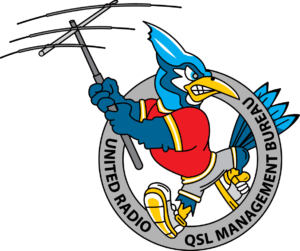 A short update that I’ve been wanting to write for some time now. All QSL cards for YOTA, 7X5KBS, DM500RT, V31PS and other calls are now 100% up to date as of last week. Please expect to receive your QSL cards soon!
A short update that I’ve been wanting to write for some time now. All QSL cards for YOTA, 7X5KBS, DM500RT, V31PS and other calls are now 100% up to date as of last week. Please expect to receive your QSL cards soon!
Remember, I provide a guarantee with all letters. If you have not received your QSL card, please email me within 2 months of the letter being posted and I will send a replacement free of charge.
Do you need a QSL manager? Well look no further. Click here for everything you need to know!
Philipp, DK6SP (20 years), and I, M0SDV, (17 years), will be QRV from Bonaire as PJ4/homecall from 16.03.2018 – 02.04.2018. Operation will take place at the QTH of PJ4DX.
We will try to be QRV from 160m through 6m focusing on WARC bands outside of the contest.
Modes will be mostly CW and SSB but also digital modes like RTTY or FT8 are planned. The activity also includes participation in the upcoming CQ WPX SSB 2018 contest. Operators will be DK6SP, M0SDV, PJ4DX, PJ4KY and PJ4NX. Category and contest call will be announced in time.
During our stay on Bonaire there is also a trip planned to another DXCC in the Caribbean. Please see Twitter for Live updates
QSLs will be via home calls for both operations.
We would like to say an enormous Thank you to Steve PJ4DX for loaning us his equipment and helping us along the way! We couldn’t have done it without you!
Also Thank you to DX Commander and G3TXQ Hexbeams for antenna loans!

QSL cards have been posted 75 World Bureaus – Saturday 23rdSeptember 2017
This mailing is a joint mailing between M0OXO Charles, M0URX Tim & M0SDV Jamie
I would very much appreciate feedback from you when the QSL cards start arriving at World Bureaus or received by hams around the world? This feedback will be added to our data below.
This mailing features cards from the recent expeditions. The parcels are sent by Priority Business Mail to get to the Bureaus quickly.
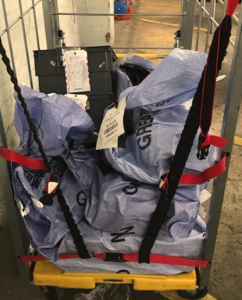
Total amount of QSL cards 12,067
Via M0URX 2,948
Via M0OXO 7,406
Via M0SDV 1,300
Via MD0CCE 313
Via G4IRN 100
Total Weight 45,225 g (gross weight includes packaging)

